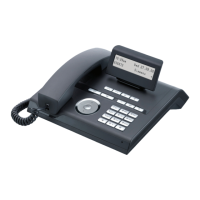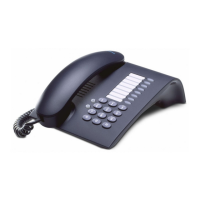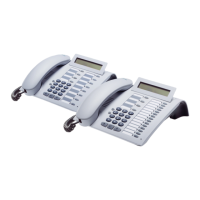Do you have a question about the Siemens Hicom 300 E and is the answer not in the manual?
Provides context and overview of the user guide's content.
Covers essential safety warnings and precautions for telephone usage.
Details the distinct features of the optiPoint 500 economy, basic, standard, and advance models.
Explains the purpose and operation of various keys on the telephone interface.
Explains how to interpret the manual's structure and the meaning of its symbols.
Covers direct, Service Menu, and function key methods for activating features.
Outlines basic, multiline, and executive/secretary function types.
Provides advice on optimizing telephone usage and call management.
Instructions for answering calls via handset and speakerphone.
Procedures for activating, deactivating, and responding to waiting calls.
Managing mailbox messages and handling callback requests.
Covers stop voice calling, headset usage, and do not disturb features.
Steps for dialing with the handset off-hook and on-hook.
Suppressing caller ID and direct colleague calling via loudspeaker.
Using tone dialing for system commands after dialing a number.
Initiating consultation calls and switching between active calls.
Setting up conference calls and understanding system-supported conferences.
Adding participants to conferences and transferring conference calls.
Viewing conference member details and disconnecting participants.
Procedures for transferring calls with and without prior announcement.
Utilizing the switchover button for call management functions.
Accessing and navigating the call history.
Dialing from call logs, deleting entries, and using saved number redial.
Utilizing individual and system speed dialing for efficient calling.
Assigning calls to projects using service codes and PINs.
Information on how call duration or cost is displayed on the phone.
Requesting callbacks and managing requests.
Checking/cancelling callbacks and using the camp-on feature.
Intruding on occupied lines for urgent communication.
Modifying the volume and pitch of the incoming call alert.
Customizing speakerphone sensitivity and alerting tone volume.
Adjusting display contrast and angle for optimal viewing.
Preventing unauthorized use via PIN or chip card.
Saving frequently used numbers on programmable keys.
Saving individual speed dial numbers and assigning functions to keys.
Programming and removing timed reminders for appointments.
Testing keys, display, and audio components for proper operation.
Checking pre-assigned or user-saved functions on telephone keys.
Explains fixed and variable call forwarding options and their behavior.
Programming and enabling fixed call forwarding destinations.
Selecting and setting up different types of variable call forwarding.
Using automatic call forwarding and activating/deactivating via switch.
Setting up call forwarding to other telephones.
Configuring call forwarding for specific conditions like fax, PC, or busy lines.
Verifying and disabling call forwarding for other telephones and services.
Logging onto other telephones using a personal identification number.
Using chip cards for remote access and deactivating identification.
Steps for moving a telephone to a new station line.
How line keys facilitate team calls and line management.
Interpreting the different states of line key lamps.
Procedures for answering incoming calls on line keys by priority or offer order.
Placing calls on hold and retrieving them, including exclusive hold options.
Handling calls when a team member is unavailable.
Parking calls and resuming them at different telephones within a call pickup group.
Using DSS keys to call team members and understanding key lamp statuses.
Making calls to or from the executive and secretary's offices.
Handling executive calls received in the secretary's office or during ongoing calls.
Forwarding executive calls and taking them on their telephone.
Methods for labeling telephone keys with functions or numbers.
Attaching emergency labels and accessing user manuals.
Overview of optional accessories available for customizing the telephone.
Guidance on phone maintenance and resolving common issues.
Interpreting and resolving common error messages shown on the phone display.
Guidance on when and whom to contact for persistent telephone problems.
Quick reference for basic call making, redialing, and call mode switching.
Summarized procedures for consultation, toggling, and extending calls.
Concise instructions for setting up conferences and call forwarding.
Quick guides for saving speed dial numbers and timed reminders.
Lists Service Menu functions, their access codes, and related options.
Provides context and overview of the user guide's content.
Covers essential safety warnings and precautions for telephone usage.
Details the distinct features of the optiPoint 500 economy, basic, standard, and advance models.
Explains the purpose and operation of various keys on the telephone interface.
Explains how to interpret the manual's structure and the meaning of its symbols.
Covers direct, Service Menu, and function key methods for activating features.
Outlines basic, multiline, and executive/secretary function types.
Provides advice on optimizing telephone usage and call management.
Instructions for answering calls via handset and speakerphone.
Procedures for activating, deactivating, and responding to waiting calls.
Managing mailbox messages and handling callback requests.
Covers stop voice calling, headset usage, and do not disturb features.
Steps for dialing with the handset off-hook and on-hook.
Suppressing caller ID and direct colleague calling via loudspeaker.
Using tone dialing for system commands after dialing a number.
Initiating consultation calls and switching between active calls.
Setting up conference calls and understanding system-supported conferences.
Adding participants to conferences and transferring conference calls.
Viewing conference member details and disconnecting participants.
Procedures for transferring calls with and without prior announcement.
Utilizing the switchover button for call management functions.
Accessing and navigating the call history.
Dialing from call logs, deleting entries, and using saved number redial.
Utilizing individual and system speed dialing for efficient calling.
Assigning calls to projects using service codes and PINs.
Information on how call duration or cost is displayed on the phone.
Requesting callbacks and managing requests.
Checking/cancelling callbacks and using the camp-on feature.
Intruding on occupied lines for urgent communication.
Modifying the volume and pitch of the incoming call alert.
Customizing speakerphone sensitivity and alerting tone volume.
Adjusting display contrast and angle for optimal viewing.
Preventing unauthorized use via PIN or chip card.
Saving frequently used numbers on programmable keys.
Saving individual speed dial numbers and assigning functions to keys.
Programming and removing timed reminders for appointments.
Testing keys, display, and audio components for proper operation.
Checking pre-assigned or user-saved functions on telephone keys.
Explains fixed and variable call forwarding options and their behavior.
Programming and enabling fixed call forwarding destinations.
Selecting and setting up different types of variable call forwarding.
Using automatic call forwarding and activating/deactivating via switch.
Setting up call forwarding to other telephones.
Configuring call forwarding for specific conditions like fax, PC, or busy lines.
Verifying and disabling call forwarding for other telephones and services.
Logging onto other telephones using a personal identification number.
Using chip cards for remote access and deactivating identification.
Steps for moving a telephone to a new station line.
How line keys facilitate team calls and line management.
Interpreting the different states of line key lamps.
Procedures for answering incoming calls on line keys by priority or offer order.
Placing calls on hold and retrieving them, including exclusive hold options.
Handling calls when a team member is unavailable.
Parking calls and resuming them at different telephones within a call pickup group.
Using DSS keys to call team members and understanding key lamp statuses.
Making calls to or from the executive and secretary's offices.
Handling executive calls received in the secretary's office or during ongoing calls.
Forwarding executive calls and taking them on their telephone.
Methods for labeling telephone keys with functions or numbers.
Attaching emergency labels and accessing user manuals.
Overview of optional accessories available for customizing the telephone.
Guidance on phone maintenance and resolving common issues.
Interpreting and resolving common error messages shown on the phone display.
Guidance on when and whom to contact for persistent telephone problems.
Quick reference for basic call making, redialing, and call mode switching.
Summarized procedures for consultation, toggling, and extending calls.
Concise instructions for setting up conferences and call forwarding.
Quick guides for saving speed dial numbers and timed reminders.
Lists Service Menu functions, their access codes, and related options.
| Type | PBX |
|---|---|
| Protocols Supported | ISDN, analog |
| Features | Call forwarding, conferencing |
| Lines | Analog |
| Protocol | ISDN, Analog |











